Almost an hour later I was dragged into the real world by yet another alarm. This was a carbon monoxide alarm in a top corner of the cabin. In a dazed state I tried to remove it from its fitting. I couldn't, but the sound stopped. Then the alarm burst into life again. I somehow managed to remove it from its mounting, then realising I would have to search for screwdrivers to remove the battery, I put it into a drawer to drown the din. That seemed to amplify the sound, so in desperation I went out into the cockpit, lifted one of the hatches and drop it inside there. Peace at last I hoped.
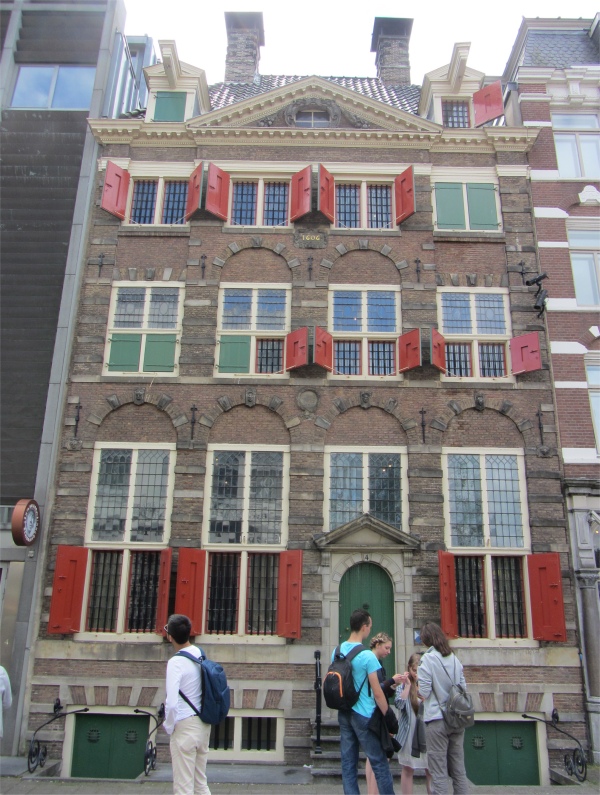 Rembrandt House Museum with New Wing to the Left |
In the morning I put forward my theory to Rex. "We've been nursing the engine ever since we left the UK. The gas alarm immediately above the engine gave us the first clue that something was wrong, then we could smell the exhaust fumes in the engine compartment and see wisps of blue haze. That hints at perhaps a leaking exhaust manifold. The fumes spread below decks setting off the gas alarm by the water tank, and then we could smell the fumes in the heads. What I think happened through the night was a series of coincidences. We had used the engine through the day, and a bright sunny afternoon had heated up the rear of the boat, including the engine compartment. I reckon the warm gasses in the engine bay, coupled with a breeze in the right direction, had caused the gasses to leak up into the cabin, setting off the two alarms. I'll stick with that theory unless you've got a better one."
"That sounds logical to me," replied Rex.
"Now, as far as what we do about it, well we both agree that the exhaust system needs to be checked and rectified, but that is a job to be done back in the UK. Meanwhile, we can go on indefinitely as long as we don't use the engine. When we do use the engine, we should open up a floor panel above the engine in the cockpit to prevent fumes building up. That approach should tide us over till we get back to home shores."
Rex thought that would be a sensible approach.
Today, we decided to follow our individual interests. Rex wanted to visit the maritime museum that the elderly man in the Dutch Cape Horners Foundation in Hoorn had praised. As for me, I recalled watching an interesting program concerning the Rembrandt House Museum several weeks before we left the UK. So that was my objective for the day.
Due to the fiasco through the night, it was well into the afternoon before we parted company at Centraal Station. Within a short space of time I was sheltering in a coffee house from a shower; an opportunity to observe some of the absurdities of our species. Then, rather than get a tram, I hiked to the museum.
 Kitchen |
Leiden did not offer much in the way of artistic talent, and in 1624, after three years with a local painter, Rembrandt went to Amsterdam to study briefly with Pieter Lastman. He then moved back to Leiden and set up as an independent painter, sharing a workshop with Jan Lievens. It was not an easy climate in which to work. Following the Protestant Reformation, the local churches no longer provided artists with any commissions as the Catholic Church did in other countries. As a consequence artists had to concentrate on commissions from private individuals. Rembrandt quickly began to make a name for himself as a painter of historical subjects.
Unusually, Rembrandt did not follow the advice that was given to young painters, namely to travel to Italy to study Italian art first hand. Instead he felt that he could learn everything he needed to from the art available in his native country.
 Courtyard |
Rembrandt lodged in the house of an art dealer called Hendrick van Uylenburgh, and while there, he met his landlord's young cousin Saskia. They were married in 1634. The numerous paintings and drawings of her suggest the two were very happily married. In 1636, Saskia gave birth to their first son, Rumbartus. He died after only two weeks. Over the next four years two more children were born, but died within a couple of months.
Professionally, Rembrandt went from strength to strength. The most important families and organisations in the city commissioned paintings. As well as portraits, he produced baroque history paintings such as Belshazzar's Feast. Cash flow was sometimes a problem - and Rembrandt's cash flowed rather freely. He was a compulsive buyer of art, and a collector of all manner of antiquities, props, and weapons to be used in paintings. Saskia's family accused him of squandering her fortune. But Rembrandt was the most famous artist in the city. What could go wrong?
The artist had great success with his paintings and etchings. He also made very good money from teaching his pupils. In 1639, Rembrandt and Saskia moved into a grander house, next to his old friend van Uylenburgh. He could certainly afford the substantial sum of 13,000 guilders that his house cost. This was the house I was visiting, and eventually became the Rembrandt House Museum. He sketched endlessly - people on the street, beggars, circuses, women and children. His painting was influenced by new developments in Italian art which reached the Netherlands via prints, and via his more travelled colleagues. Many of his contemporaries had started to experiment with the dramatic use of lighting developed by Caravaggio.
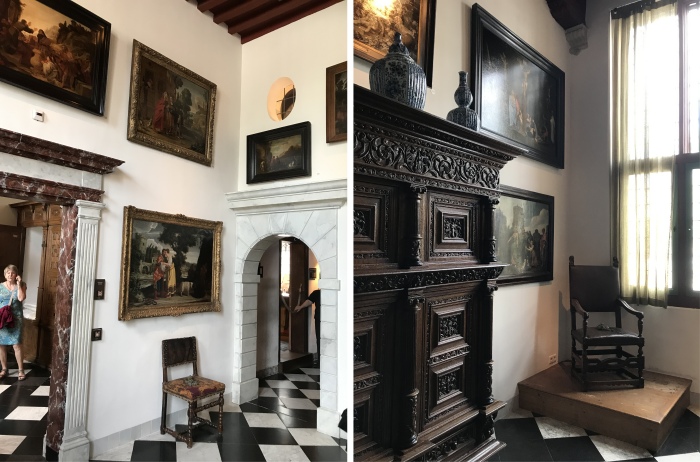 Entrance Hall |
In 1641 a fourth child, Titus, was born, and lived. Saskia was unwell after the birth and Rembrandt made various drawings of her looking tired and drawn in bed. In 1642, Saskia made a will leaving Rembrandt and Titus her fortune, although most of Rembrandt's share would be lost if he married. She died shortly after, still aged only 30, probably from plague or TB.
Alone with a baby to care for, Rembrandt had to employ a nurse and took on a widow called Geertge Dircx. She became his common law wife for a short time, but then he took on another servant, Hendrickje Stoffels, and fell in love with her. Geertge took Rembrandt to court on the grounds that he had promised to marry her. He charged her with pawning some of Saskia's jewellery that she had left to Titus in her will. After much bitter wrangling, Rembrandt somehow had her sent to a house of correction. Meanwhile he and Hendrickje lived happily together, except that the terms of Saskia's will meant that he couldn't afford to marry her. She appears in numerous paintings, and may have been the model for A Woman Bathing.
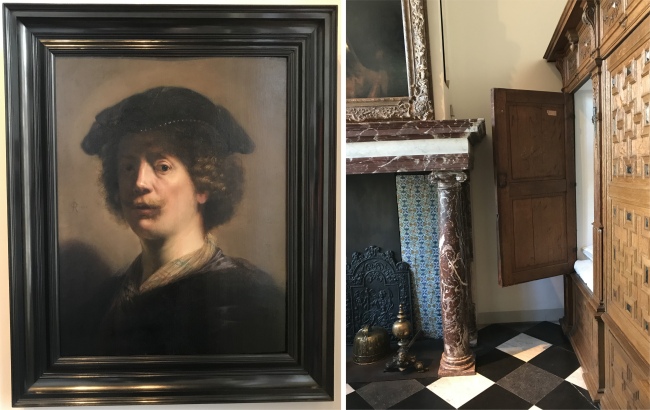 Anteroom |
Titus married in 1668 the daughter of an old family friend, then seven months later, he died. A daughter, Titia, was born six months later. In 1669, Rembrandt himself died and was buried in the Westerkerk next to Hendrickje and Titus. There was no official notice of his death.
So, here I was standing in Rembrandt's house in Jodenbreestraat, where he had lived from 1639-1658. Many of his masterpieces were painted in this period, among them his Self-Portrait (1640), The Night Watch (1642), Aristotle (1653), Woman Bathing (1654) and Portrait of Jan Six (1654).
An inventory from the 17th century was used to carefully refurbish the house with furniture, art and objects from Rembrandt's day. The house unfolded aspects of Rembrandt's life that I had been totally ignorant about. It told a story of Rembrandt the man, artist, teacher, inspirer, collector and entrepreneur. A prolific painter, draftsman, and etcher, Rembrandt is usually regarded as the greatest artist of Holland's "Golden Age."
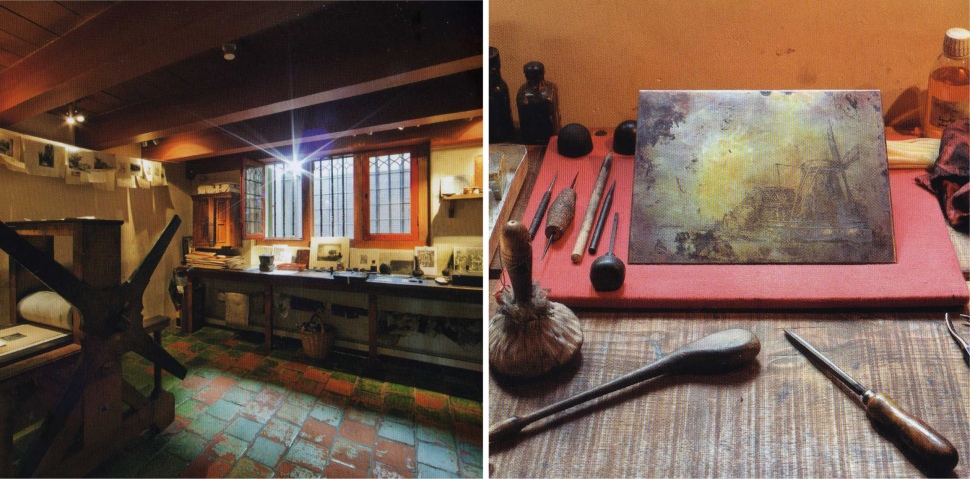 Etching Room |
I wandered through the kitchen, the centre of activity in the house, where the household cooked and ate. The maid slept in the box bed, a bed typical of the age where people slept sitting up believing they would die if they slept laying down. A cesspit in the courtyard outside the kitchen revealed the stratum of 17th century finds from Rembrandt's time.
 Salon |
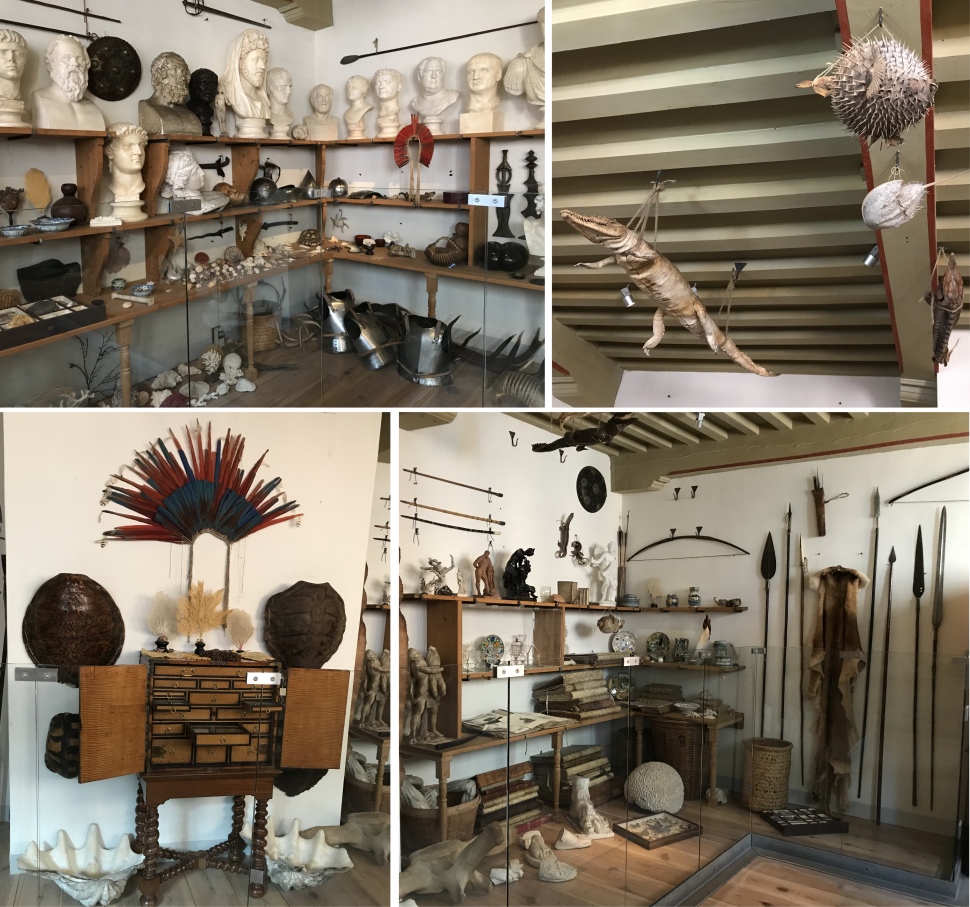 Art Cabinet |
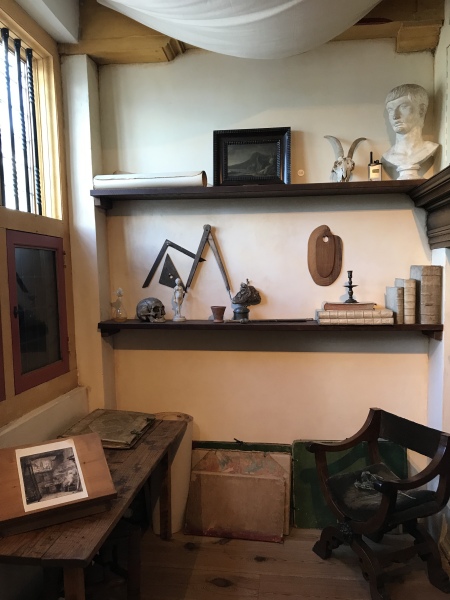 Large Studio |
I hung around near the entrance to this room in order to catch one of the daily demonstrations of engraving and etching techniques. A lady described the tools, equipment and materials that would have been used in this workshop, and went on to describe the three main techniques employed, showing examples of each.
Drypointing is the most direct way to make a print, scratching onto a copperplate with a heavy steel needle or diamond point. As the needle is drawn through the plate, copper is pushed up onto the surface. This is known as the "burr". The plate is then inked to allow the ink to collect around these scratches and the rest of the plate is wiped clean. The printed line is best described as "furry" similar to a line drawing in charcoal. This unmistakeable quality, however, soon disappears after limited printing as the burr is extremely delicate and will wear quickly. A steel-faced plate gives longer durability.
Engraving employs a burin and not a needle, and by pushing it along the copper surface, it gouges out a line from which a spiral of metal is displaced. This spiral must be cut off using the flat side of a scrapper.
The third technique involves the process of etching. The plate is coated with a mixture of asphalt, resin and wax, known as the etching ground. This coating is resistant to acid. A scene or design is drawn into the coating using an etching needle. The metal is exposed where the needle goes through the etching ground. The plate is then submerged in a bath containing an acid solution. The acid bites out - etches - the exposed lines of the drawing, creating grooves in the plate. The etching ground is removed and the clean plate is inked with an ink-pad. The surface is then wiped largely clean, the ink remains in the grooves. The etching plate is placed on the bed of the press with a piece of dampened paper on it. The plate and paper are passed between the rollers of the press. The paper absorbs the ink from the grooves.
Rembrandt was a true master of all these techniques, often combining two or more at a time. As an illustration, the lady inked a plate, and on a reconstructed 17th century press, produced a print - a copy of Rembrandt's The Shell (Conus Marmoreus) 1650, which combined all three techniques.
The Salon was Rembrandt's living room and the room where he slept. In the 17th century the Salon was the finest room in the house. It is a high-ceilinged room housing numerous paintings, now with works by Rembrandt's most successful pupils and contemporaries, among them Ferdinand Bol, Gerbrandt van den Eekhout, Philips Koninck and Jan Lievens.
 Small Studio |
The Large Studio was where Rembrandt painted many of his masterpieces. It smelled of linseed oil and turpentine, and in the winter of the peat that was burned in the two cast-iron stoves. These were needed to keep Rembrandt and his model (often nude) warm, as well as to dry the paint. On the shelves around the walls are objects that Rembrandt and his pupils used as props when they were painting: armour, helmets, cuirasses and weapons of all kinds, plaster casts of classical statues and body parts. Rembrandt was able to control and temper the light in this north-facing room to some extent by closing the shutters over the bottom windows and adjusting a white cloth over one of them. Rembrandt painted here while his pupils made his paints and prepared his canvases.
I was lucky enough to be there when a lady turned up into the studio to demonstrate paint-making in the 17th century. She explained how the 17th century artist had access to a limited number of pigments. There was lead white and smalt, a violet blue, made from ground glass, and azurite, a bluish green mineral pigment. Many yellow and red types of ochre were also used, as were lakes made from insects or plants. Rembrandt used just twelve pigments in his lifetime, in his later paintings sometimes only six. He was a master at mixing a range of colours from a limited number of pigments, usually earth pigments, ochre and lead white. Paint was made by mixing a pigment with oil as a binder by grinding on a large, flat stone - the grindstone - to make the paint. The lady demonstrated the process. Linseed oil was widely used; it dries quite quickly and has an attractive glow. By contrast olive oil never dried.
There was also a Small Studio, an attic room, which was used by Rembrandt's pupils. Separate cubicles for four or five apprentices were created here with wooden partitions or curtains.
The Rembrandt House also holds an almost complete collection of Rembrandt's world-famous etchings. Of the 290 or so etchings he made, the museum has 250. It also owns four of Rembrandt's original etching plates. A room is reserved for displaying a selection in the museum.
 Selection of Etchings |
Then I thanked my children for their Father's Day wishes. Finally, I spent some time on the wording for an email to Alan. His wife, Carol, had recently been tragically killed in a car crash, and my email was to accept his invitation to a Celebration of the Life of Carol.
My mind wandered through a maze of bitter/sweet memories for a while, but I snapped out of it and hiked (a fast hike always helps to clear the mind) around the city, capturing a few photos before returning back to Duonita.
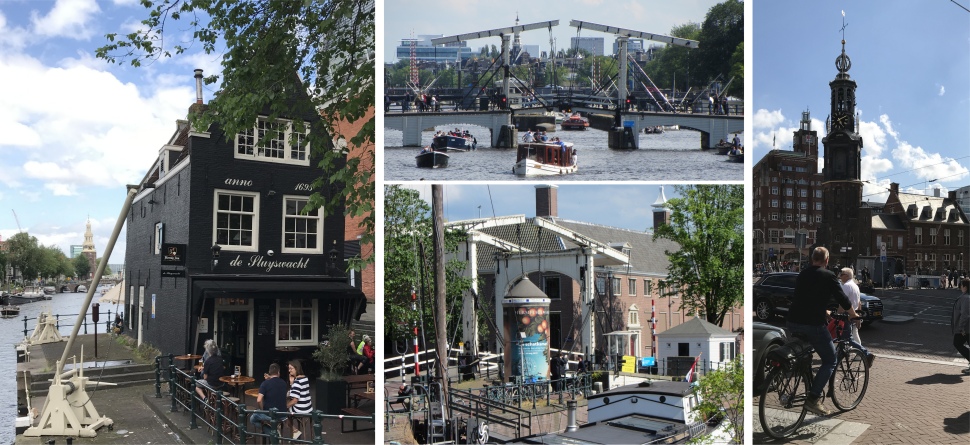 Random Views on my Hike |
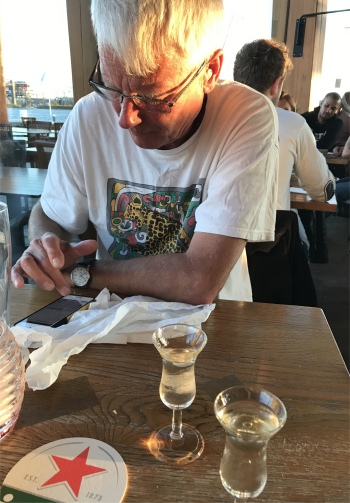 Rex Checking the Weather in the Loetje |
We decided we had done enough hiking for the day, and settled for eating and drinking at the Loetje, the marina restaurant, in the evening. It is a very popular venue, so we reserved a table accepting that we would have to wait for an hour. Naturally, we sat outside overlooking the marina and sipped a beer. As we put the world to rights, we watched a man at the top of the very tall mast of a large yacht only 20m away from our berth. Afterwards, a gang of men heaved a heavy foresail over the deck, hoist it, and manage to furl it on the second attempt.
I enjoyed a steak done in a Bali sauce - a fiery, peppery sauce - yum!
